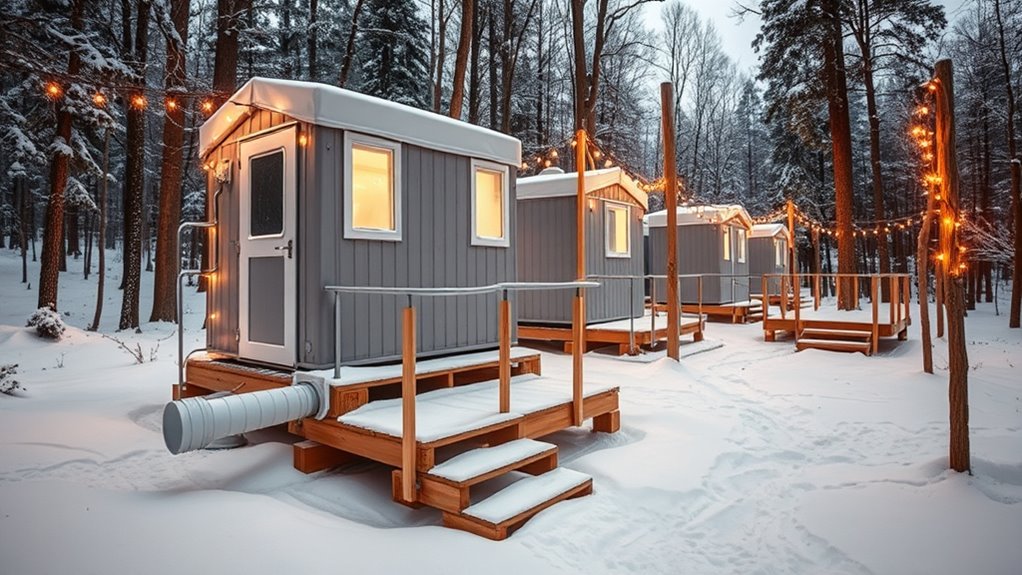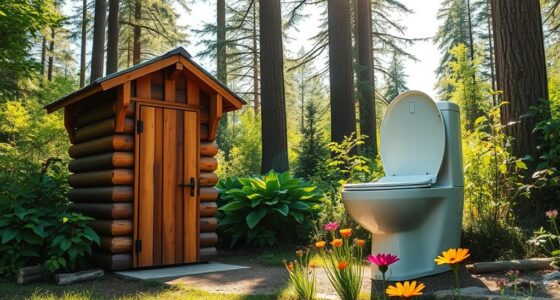To winterize portable restrooms for cold-weather glamping, start by inspecting all plumbing connections, valves, and hoses for leaks or damage. Drain any residual water and add insulation or heat tape around exposed pipes to prevent freezing. Clear snow and ice promptly around the units, and keep walkways salted or sanded for safety. Regularly check ventilation systems and moisture levels to avoid issues. For detailed steps and tips, keep exploring how you can protect your investment during winter months.
Key Takeaways
- Inspect and secure all plumbing connections, installing insulation or heat tape to prevent freezing during cold-weather glamping.
- Drain residual water from systems and disconnect hoses to avoid pipe bursts in freezing temperatures.
- Regularly clean, sanitize, and check ventilation to maintain hygiene and prevent moisture buildup inside units.
- Clear snow and ice from walkways, applying salt or sand for safety and easy access to portable restrooms.
- Train staff on winter maintenance procedures and establish routine inspections to address issues proactively.

Are you ready to get your outdoor space prepared for the changing seasons? Winterizing your portable restrooms is vital to ensure they stay functional and hygienic during cold-weather glamping. The first step is understanding the importance of winter maintenance, especially when it comes to plumbing protection. Cold temperatures can cause pipes to freeze and crack, leading to costly repairs and potential service disruptions. By taking proactive measures, you can prevent these issues and keep your facilities in top shape throughout the winter months.
Start by inspecting the plumbing system of each portable restroom. Make sure all valves, hoses, and connections are secure and in good condition. Any leaks or weak points can become problematic once temperatures drop. Installing pipe insulation or heat tape around exposed plumbing helps prevent freezing. These simple investments can make a significant difference, especially if your site experiences severe cold snaps. You should also consider draining any residual water from the system if the restrooms won’t be used for an extended period. Removing water minimizes the risk of freezing and bursting pipes.
Next, focus on winter maintenance practices that can extend the life of your portable restrooms. Regular cleaning and sanitizing are vital, but during winter, you’ll want to pay extra attention to the interior and exterior surfaces. Clear away snow and ice promptly to maintain safe access for users and maintenance staff. Keep walkways clear and salted or sanded as needed to prevent slips and falls. Additionally, check the ventilation system to ensure it’s working properly, as poor ventilation can lead to moisture buildup and freezing issues inside the units. Understanding relationships and how they influence maintenance routines can help in planning effective winter strategies.
Don’t forget to prepare your staff with proper training on winter maintenance procedures. They should know how to inspect for potential plumbing problems, apply insulation, and perform routine checks that help identify issues early. Having a schedule for regular inspections during the winter season ensures any problems are caught before they escalate. It’s also wise to keep spare parts on hand, such as hoses, fittings, and insulation materials, so you can quickly address any unexpected issues without delays.
Frequently Asked Questions
How Do I Prevent Frozen Pipes in Portable Restrooms During Winter?
To prevent frozen pipes in portable restrooms during winter, you should insulate the pipes with pipe insulation to keep the cold out. Additionally, add drain antifreeze to the water lines to lower the freezing point and prevent ice buildup. Make sure to drain any water from the system when not in use and keep the restroom in a sheltered area if possible. These steps help guarantee your portable restroom stays functional in cold weather.
What Eco-Friendly De-Icing Options Are Safe for Portable Units?
When tackling icy challenges, you want solutions that are gentle on your environment. Opt for biodegradable de-icers or natural ice melts—they’re safe for your portable units and won’t harm the surroundings. These eco-friendly options effectively melt ice without the harsh chemicals found in traditional de-icers. By choosing natural ice melts, you keep your restrooms accessible and your site eco-conscious, ensuring a cozy winter experience for everyone involved.
How Often Should Portable Restrooms Be Serviced in Cold Weather?
In cold weather, you should service portable restrooms more frequently to guarantee cleanliness and proper functioning. Maintain a regular maintenance schedule, ideally checking every 24 to 48 hours, especially if usage is high. This includes restroom cleaning, replenishing supplies, and inspecting for issues. During extreme cold, more frequent visits might be necessary to prevent freezing and ensure comfort for users. Always adapt your schedule based on occupancy and weather conditions.
Can Portable Restrooms Be Heated Without Electricity?
Think of portable restrooms as cozy cabins in winter—can they stay warm without electricity? While you can’t run traditional portable heaters, you can use portable restroom insulation to help retain heat. For heating options without electricity, consider portable heater options like propane or kerosene heaters, but always prioritize safety. These alternatives can keep your facilities comfortable, ensuring guests enjoy their cold-weather glamping experience without freezing.
What Are Winterizing Tips for Portable Restroom Waste Tanks?
To winterize portable restroom waste tanks, you should start by adding chemical treatments that prevent freezing and control odors. Insulating the tank with foam or insulated blankets helps retain heat and guard against cold temperatures. Make certain to drain and clean the tank thoroughly before winter, and consider using antifreeze solutions if temperatures drop considerably. These steps guarantee your waste system stays functional and odor-free throughout the winter months.
Conclusion
As winter approaches, your preparations are essential—but what surprises might the cold bring? By winterizing your portable restrooms now, you’re not just protecting your site, you’re set to face unforeseen challenges head-on. Will your efforts hold up against the harshest weather? Only time will tell. Stay vigilant, keep your plans flexible, and remember: the true test of your prep begins when winter’s chill truly sets in. Are you ready?









